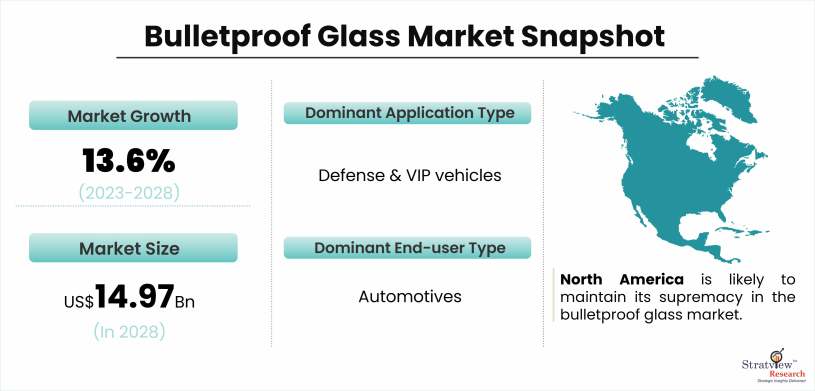In an era marked by increasing concerns over safety and security, the demand for innovative protective solutions has reached an all-time high. One such technology that has gained prominence is bulletproof glass, a revolutionary material that offers a clear shield against potential threats. From banks and government buildings to vehicles and homes, bulletproof glass is now a critical component in fortifying structures and protecting lives. In this article, we will delve into the factors driving the rise of the bulletproof glass market and its various applications across different sectors. The bulletproof glass market is estimated at US$ 6.94 Billion in 2022 and is expected to grow at a CAGR of 13.60% during 2023-2028 to reach US$ 14.97 Billion in 2028.
Bulletproof glass, also known as ballistic glass or bullet-resistant glass, is a specialized composite material engineered to withstand penetration from bullets, explosives, and other ballistic threats. Unlike conventional glass, bulletproof glass is designed to absorb and dissipate the energy from impacts, preventing the formation of lethal projectiles that could harm people and property. The origins of bulletproof glass can be traced back to the early 20th century when it was first used in military applications. However, in recent years, advancements in materials science and manufacturing techniques have made it more accessible and affordable for commercial use.
One of the key drivers behind the surge in the bulletproof glass market is the growing concern over public safety and security. With the rise in mass shootings, armed robberies, and terrorist attacks worldwide, governments, businesses, and individuals alike are seeking effective measures to protect their assets and personnel. Bulletproof glass provides a reliable and transparent solution to bolster security in vulnerable locations like banks, embassies, police stations, and high-profile government buildings.
Moreover, bullet-resistant glass is not limited to security installations alone. The automotive industry has witnessed a significant rise in demand for bulletproof glass, especially for VIP and high-security vehicles. Celebrities, politicians, and corporate executives are opting for armored cars equipped with bulletproof glass to mitigate potential risks while on the move. Additionally, the use of bulletproof glass in residential properties has become more prevalent, providing homeowners with an extra layer of protection against burglary and intrusions.
Another factor contributing to the growth of the bulletproof glass market is the continuous technological advancements in the field. Researchers and manufacturers are constantly pushing the boundaries of material science to develop stronger, lighter, and more cost-effective bullet-resistant materials. Traditional bulletproof glass, although highly effective, can be heavy and cumbersome, making it challenging to integrate into certain designs and structures. However, with advancements in nanotechnology and composite materials, new generations of bulletproof glass offer enhanced performance without compromising aesthetics and practicality.
Furthermore, the bulletproof glass market has expanded its reach to new geographies and industries. As the awareness of security threats spreads globally, countries with significant political instability and high crime rates are witnessing a surge in demand for protective solutions like bullet-resistant glass. This market expansion, in turn, encourages manufacturers to innovate further and develop tailored solutions for specific needs, leading to a positive feedback loop of growth and development.
Despite its numerous benefits, bulletproof glass does have some limitations. While it can withstand bullets and reduce the risk of injuries, repeated and sustained attacks can eventually compromise its integrity. Additionally, the cost of installing bulletproof glass can be substantial, which may deter some smaller businesses and homeowners from adopting this technology.
In conclusion, the rise of the bulletproof glass market is a response to the growing need for security and protection in an increasingly uncertain world. Its applications span across various sectors, including government, finance, automotive, and residential domains. As technology continues to evolve and global security concerns persist, the bulletproof glass market is likely to see further growth, offering a clear shield to safeguard lives and assets in an unpredictable landscape.





Comments